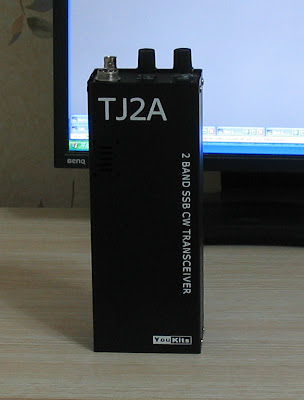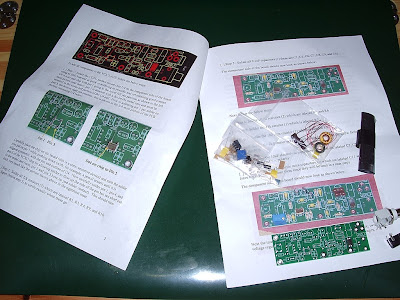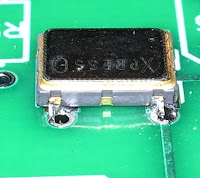Posts Tagged ‘Kit Building’
 Winter hibernation plans
Winter hibernation plans
| Some winter fun projects |
| What is wrong with this picture? |
 A Look Back at the Heathkit AT-1 [VIDEO]
A Look Back at the Heathkit AT-1 [VIDEO]
With Heathkit‘s recent announcement of them getting back into the kit building business, and Amateur Radio is one of those category of kits coming back, I thought that this little video look at Heathkit’s first Amateur Radio kit would be a good way to celebrate that.I know they announced it some time ago, but better late then never right? Well, this video wasn’t uploaded till about a month ago and I just found it. But You’re the first ones I’m sharing it with. My only complaint about this video, is the presenter is very mono tone. He doesn’t sound enthused with anything. But all in all, it’s still a nice video. Hope you enjoy!
73.
Rich also writes a Tech blog and posts stories every Tuesday and Thursday on Q103, Albany’s #1 Rock Station website, as well as Amateur Radio stories every Monday thru Friday on AmiZed Studios and hosts a podcast called The Kim & Rich Show with his fiance’ Kim Dunne.
 Making the K2 portable……..
Making the K2 portable……..
| KAT100 in new enclosure |
enclosure to house both the KAT100 and KPA100. I have completed the external antenna tuner. It went very smooth
| Toroid lineup |
| Bifilar winding |
| Above KAP100 waiting to be installed below from panel assembly |
If you are ever thinking of doing this project with your K2 below are some links that helped me out.
KK7P offers some very good advice along with some excellent pictures as well.
Wilcox Engineering also have some nice pictures of the unit and advice.
 Elecraft K3 Assembled in 7 Minutes [VIDEO]
Elecraft K3 Assembled in 7 Minutes [VIDEO]
So after oversleeping this morning, I managed to find a nice video that I can share with all of you. It’s nothing groundbreaking. It’s just a time lapse video of a gentleman putting together an Elecraft K3 from unboxing to finish. Pretty interesting to see the process. I have yet to build from a kit, but this is pretty cool. So watch it and enjoy. In the mean time, I’m going to go have a snooze or something. But here ya go.
 Heathkit Staging a Comeback Too?
Heathkit Staging a Comeback Too?
I’ve been seeing on the googles and the twitters, that HeathKit is going to start selling kits again, but not for Ham Radio. They are going to start selling “Do It Yourself Kits” for around the house. While this is great, It’s kind of useless for me.
The first two kits they are offering is a garage parking assistant and a wireless swimming pool monitor. I’m sure these will be great kits and lots of fun to build for many people out there, but not for me. You see, I live in an apartment. Curses, foiled again! But in seriousness, with Heathkit’s come back, it kind of makes me wonder why now? I’m guessing the economy is not what it used to be and money is getting a little tighter. So they are just firing up an old revenue stream that has been dormant a long time and getting back to what worked?
I have never built from a kit, but I have owned kit made electronics before, buying them after the person who made them, then got tired of them. I used to own a nice Heathkit AM/SSB HF transceiver back in the early days of my license. I think it was around the time I upgraded to General Class. While they haven’t started offering anything Ham Radio related yet, they are looking for suggestions for new projects. A couple that come to mind for me would be, an APRS kit and maybe a small CW or SSB transceiver for backpacking or mobile use. That would have to be pretty rugged though, so not sure how that would play out.
But with Radio Shack also getting back into the DIY arena too, things are starting to come full circle and we’ll have a new generation of kids able to build some pretty cool things on the weekends, keeping them off the interwebs thingy and the facebook doo-dads. Maybe even a return to the catalogs we would get every now and again, and would eagerly await in the mail, like I used to wait for the Sears and Montgomery Wards catalogs for Christmas to see all the toys. But being the 21st century, the catalogs would be in PDF format, and delivered by email.
73.
Rich also writes a Tech blog and posts stories every Tuesday and Thursday on Q103, The Rock of Albany’s website, as well as Amateur Radio stories every Monday thru Friday here on AmiZed Studios.
 Should I or shouldn’t I?
Should I or shouldn’t I?
Thanks to the latest blog post from John AE5X I have the web page for a new QRP kit open in another browser tab and the pointer keeps hovering over the Buy Now button. The kit in question is the TJ2A, a two-band handheld SSB/CW transceiver for the 20m and 40m bands that has just been produced by YouKits of China.
Regular readers of my blog will know of my fondness for handheld radios. I’m finding this one very hard to resist even though I have an FT-817 and so no need for another handheld 20m/40m radio. At this point in my life I’m not even sure if building it is still within my capabilities. If I did try, it would be the most difficult kit I have attempted since my Elecraft K2, and I built that 12 years ago when my eyes were a lot sharper and I was not suffering the after effects of a brain operation. Should I or shouldn’t I?
The TJ2A looks like an updated and improved version of the Mizuho HF handhelds that were produced during the late 1970s which still fetch a tidy sum whenever they change hands on eBay. Like the Mizuhos, the TJ2A is VXO controlled and covers a portion of each of the two bands, though you can install alternative crystals if you would prefer to have full coverage of one band in two ranges. You could also choose other bands by changing the VXO crystal and bandpass filters.
The building instructions are on the web and it looks as if the kit uses mostly through hole components but there are some SMD transistors. It isn’t perfect. There is mention of warm-up drift in the first 5 minutes after switching on or changing bands. There is also a mod already to stop BFO leakthrough into the IF stages. And there doesn’t appear to be any high SWR protection for the PA so using the rig with handheld antennas – or any type of antenna that presents a mismatch prior to tune-up – might be problematic.
But it looks really cute. And it’s a kit. There are few things in ham radio more rewarding than hearing the first signals, then making the first contact, on a radio you built yourself. Should I or shouldn’t I?
 Whispering with a VCXO-AXE
Whispering with a VCXO-AXE
My VCXO-AXE WSPR transmitter kit from W5OLF came this morning. It was two weeks in the post, doubtless due to Customs which had opened the package. I wasted no time in building it, though it did take me somewhat longer to complete than it took AE5X.
The kit itself has been impressively put together. The PCB is extremely high quality and the instructions are almost of Elecraft standard. If the horrible Spectrum Communications Off-Air Frequency Standard kit had been produced to this level of quality it might not have turned out to be a failure for me. If American kit makers can produce nice silk screened and solder masked boards, why do ours make us struggle with boards that look like they were made by hand on somebody’s kitchen table?
The VCXO-AXE kit uses almost all through hole components and there is plenty of space around the solder lands. I doubt that anyone would have any trouble building this. The one part that induced a feeling of terror when I saw it was the VCXO itself.
As described, it is a “larger surface mount component.” But what I didn’t expect was that it didn’t have any pins or legs that stick out to solder to. Instead, you have to solder it so the solder goes under or up the side of the chip. You need a very fine tipped soldering iron for this. I couldn’t really see if I had successfully soldered the chip or not, so I took a couple of pictures.
The result is not very pretty, but it must have been OK because the transmitter eventually worked!
When ordering, I specified my call, locator and the supply voltage I would be using (12V, as I planned to power the transmitter off a pack of 10 NiMH batteries.) The PICAXE controller chip came programmed with this information and a power level of 33dBm – 2 watts.
On a freshly charged battery pack I was actually getting nearer 3 watts output once the PA tuning capacitor had been peaked up, but after the first few transmissions the power did drop off a bit to become nearer the advertised 2 watts.
I hooked the VCXO-AXE up to my attic MFJ magnetic loop, watched the radio-controlled clock in the shack until it rolled over to an even minute, pressed the transmit button and a couple of minutes later had my first WSPR spots.
Soon after that I had several more. No great DX, but perhaps that is just down to conditions at the moment.
The instructions warn that second harmonic suppression of this transmitter is not great and an external low pass filter is advised. However, the magnetic loop (either the MFJ or my portable Wonder Loop) has a very high Q which I am sure does a good job of attenuating out of band harmonics on its own.
My next move will be to build the little transmitter into a plastic box and use it as a hand held portable WSPR rig. It would be fun to try making a 30m base loaded whip – which should also be fairly high Q – and see how well that works. So expect some WSPRing from various locations around Cockermouth some time soon!
This was a fun project and a good morale booster to prove to myself that I can still build stuff – and with an SMT part in it, too! Thanks to Jay W5OLF for making the kit available. A 20m version would be nice, as well!
If you want to buy one of these kits for yourself you have to look on eBay, though as of right now there doesn’t seem to be any for sale.



















